Edvard Grieg - Peer Gynt
Edvard Grieg - Peer Gynt
Peer Gynt suite wasn’t original idea of Edvard Grieg. He composed it on Henrik Ibsen’s request.
Ibsen was a Norwegian dramatist who wrote a play 'Peer Gynt' in 1867 during his trip around Apennine Peninsula, in Rome, Sorrento and Ischia Island.
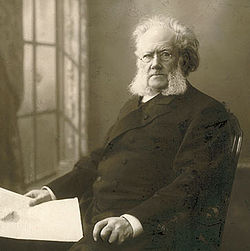
Henrik Ibsen phototographed by Gustav Borgen
The play wasn’t showed to public, although it got printed in Copenhagen. The first edition accounted for 1 250 copies. After two weeks reprints were needed – additional 2 000 units. Nonetheless the play still wasn’t presented to public. At the end of 1874 Ibsen asked Grieg to compose musical illustrations to given scenes. Grieg agreed. He finished his work in 1875. He created twenty 26 to correspond with 26 scenes from the play.
Edvard Grieg – Peer Gynt Suites
Ibsen finally showed the play - backed by Grieg’s music – in Christiania (today’s Oslo) in 1876. It wasn’t much of a success. There weren’t many performances held outside of Norway either. Most of them were probably held in America in the 20th century.
The play isn’t easy to perform. Many decoration changes prove to be a big difficulty. One of the acts takes place in total darkness which made theatres unwilling of resumption. Peer Gynt was a legendary Scandinavian hunter, whose life was full of adventures. That’s why Ibsen’s piece is more of a fantasy than a tragedy.
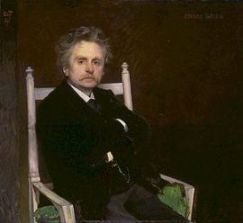
Edvard Grieg by Eilif Petersen
While Ibsen’s failed to become famous, Edward Grieg unconsciously succeeded. From 26 pieces Grieg selected 8 and grouped them into two suites.
No. 1 opus 46 consists of four parts:
- Morgenstemning (Morning Mood), - Åses død (Aase's Death), - Anitras Dans (Anitra's Dance), - I Dovregubbens hall (In the Hall of the Mountain King).
No. 2 opus 52 includes four pieces as well:
- Bruderovet. Ingrids klage. (The Abduction of the Bride. Ingrid's Lament) - Arabisk Dans (Arabian Dance) - Peer Gynts hjemfart (Stormful aften pa havet) (Peer Gynt's Homecoming (Stormy Evening on the Sea)) - Solveigs Sang (Solveig's, or Solvejg's Song).
Originally the second suite had a fifth part The Dance of the Mountain King's Daughter. Shortly however Grieg backed it out. Only the last part, Solveig’s Song has a vocal party. In later years this part is more often performed on fiddle than sung.
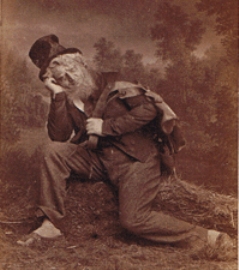
Henrik Klausen - Peer Gynt 1876
Grieg wasn’t comfortable writing to specific scenes and to Ibsen’s hints. He was to say that it was much easier to tease out the music from your own head than to go with someone else’s requests. Ibsen requested that music in fourth act had an international characteristic with Swedish, German, French and English accents. Grieg decided that this was above his temper.
Regardless of fate of the drama and problems with composing Grieg’s suites received appreciation all around the world. They became popular among symphonic orchestras who were keen to play them. They were used also in other arrangements and even in films. Single parts were also used separately, mostly ‘Morning Mood’, ‘In the Hall of the Mountain King’ and fiddlestick’s lament ‘Aase’s Heath’.
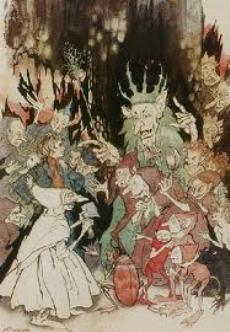
Peer Gynt - Meeting with Trolls
In recent years - thanks to Norwegians – an interest in Ibsen’s drama can be observed again. In 2006 collective venture of national theatres from Bergen and Oslo aroused quite wide feedback. Modern technology was used to create the fantastic trait of the lyrics. Super microphones, electronic music, new styling of changing decorations – all that renewed Peer Gynt to suit 21st century needs.
In April 2006 the show was held in Howard Gilman Opera House, Brooklyn Academy of Music. In the same year - as a part of The Ibsen Festival - Peer Gynt was held in Egypt under the Sphinx. This place plays a big part in art. Unexpectedly the festival was accused of promoting colonialism.
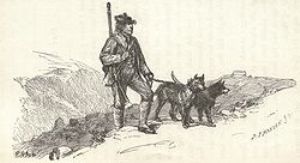
Peer Gynt - Peter Arbo illustration
In September 2007 first concert performance was held. Under direction of Vladimir Ashkenazy’s following bands appeared: Cleveland Orchestra, Oberlin College Choir, Cleveland State University Chorale. Grieg’s original version (26 parts) with addition of theatrical elements was performed in full. Actor John de Lancie was narrating, vocal parts were sung in Norwegian by Inger Dam-Jensen and Joshua Hopkins.
To me this is a very beautiful music. In it you can hear echoes of Scandinavian climate. For example in Ibsen’s play the dawn and the morning are taking place in Africa – Grieg’s morning (‘Morning Mood’) sounds fiords; ‘Anitra’s Dance’ who was a sheik’s daughter should have had an Arabic melody, but instead it is similar to Polish mazurkas.
Grieg was a Norwegian and this is distinctly reflected in his music.
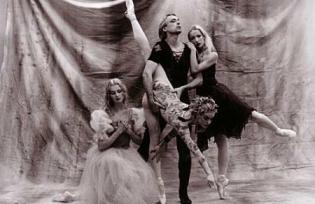
Peer Gynt - Ballet from Croatia
Last Updated (Friday, 20 March 2015 09:50)








